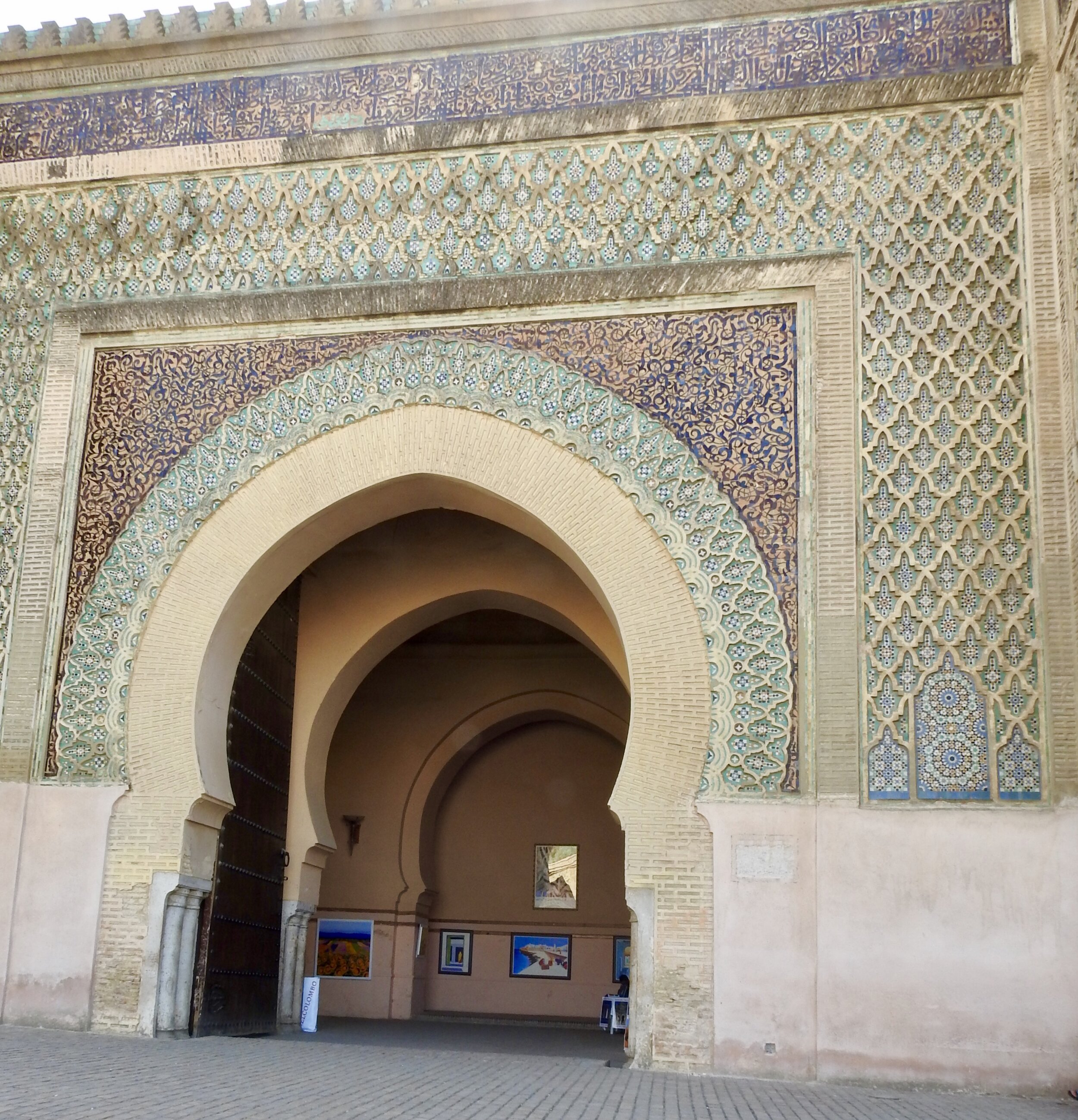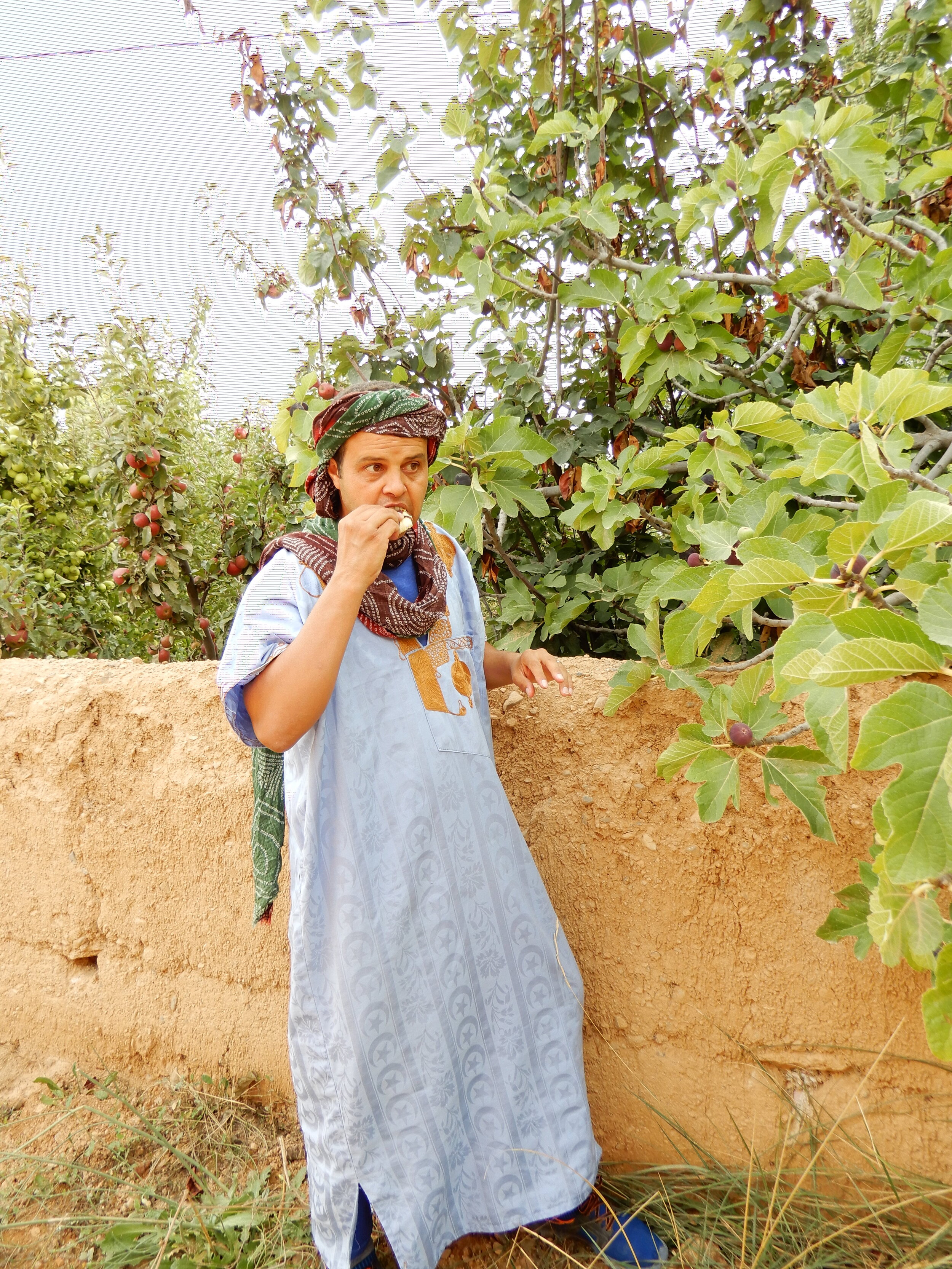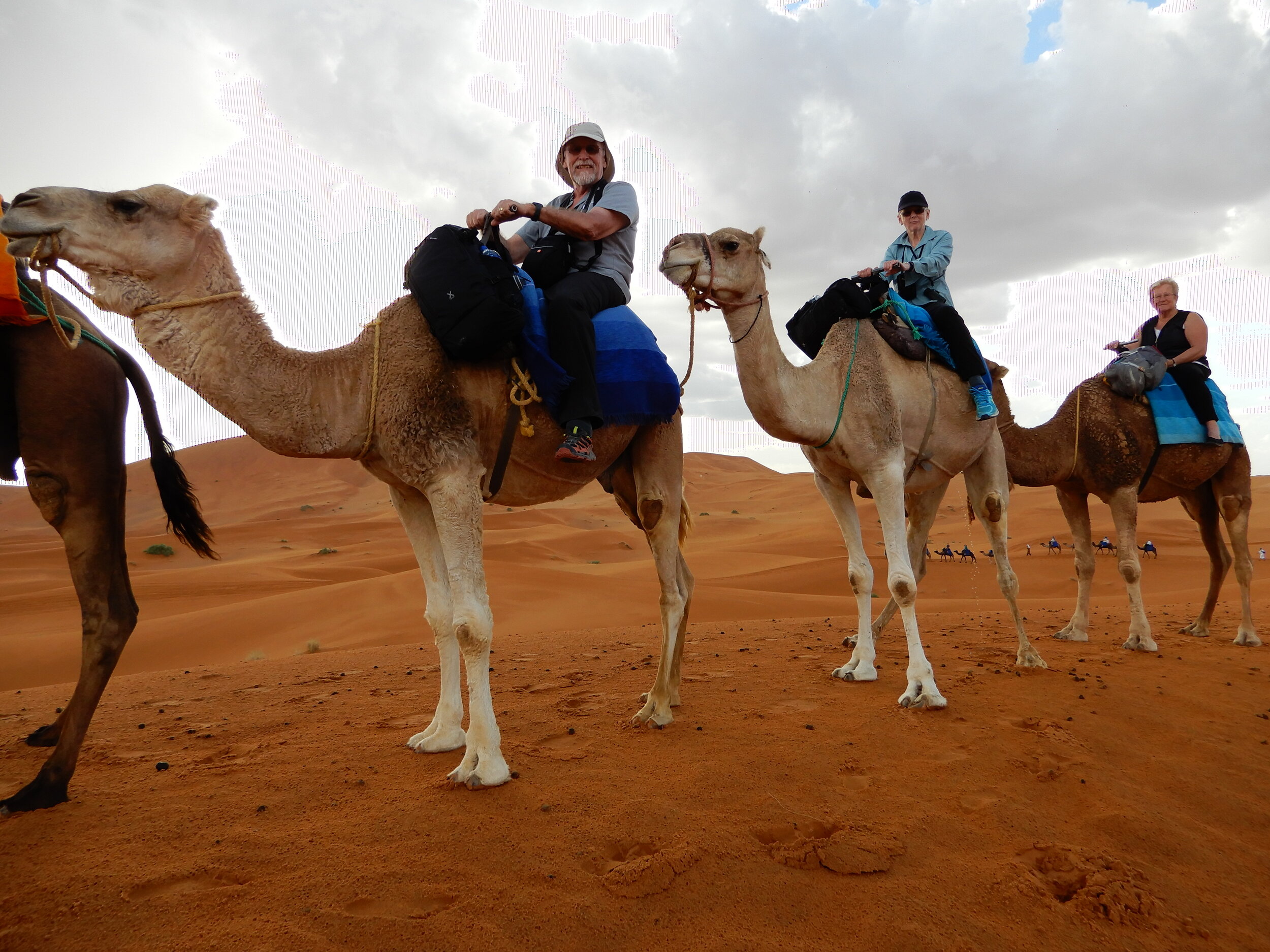This was our first sortie to North Africa - while we might have been able to identify Morocco on a blank map, we knew very little about its geography or history except in broad sweeping terms. After due diligence, we signed up for a 17 day small group tour with Peregrine Tours, an Australian based company, as it happens. There were 6 in the group, including ourselves with Norm the token male, except for Lahcen our superb tour guide! This trip was our fourth small group tour - we have found it a successful formula for us. Fortunately, the groups have been harmonious, without anyone causing friction. The tour started in Casablanca ending in Marrakech, both iconic cities in their own right, one courtesy of Bogie and Becall, and the other Crosby Stills and Nash. Our trip had a short extension - a round trip Marrakech - Essouira on the Atlantic coast.
The group met up in a hotel with little appeal in Casablanca, a rather gritty city which held little appeal to us as tourists, but it is the industrial, commercial and financial capital. We followed the usual formula: group meeting, introductions, orientation, Q & A followed by a group dinner. The only “attraction” visited whilst in Casablanca was the Hassan II mosque with its retractable roof and cantilever over the Mediterranean, Leaving Casablanca took a while as we tried to escape the suburban tentacles which are being built to accommodate the inevitable drift to the cities from smaller centres.
Casablanca & Rabat
As we approached Rabat the nation’s capital, it was easy to detect that this was a very different city - less frenzied, more orderly, more green space, cleaner. Typical was the Kasbah des Oudaias district on the edge of the Rabat Medina where the Bouru Regrew River empties into the Mediterranean. The community has been “gentrified” with lots of fresh paint and overall clean-up. Rabat is very much the capital city on display.
The destination for the day was Meknes where we had our first Riad experience at Riad d’Or. After a quick freshen up we walked through the narrow alleyways of the Medina to La Terrasse Restaurant which had a view overlooking the Place El Hadim where there was a night market that included a boxing match, musicians as well as a host of stalls. Free entertainment!
Meknes
On leaving Meknes, we first toured the Roman Ruins at Volubulis before starting to climb the slopes of the Lower Atlas with Fes as the destination. The city is famous for having the largest Medina in the country; we were relieved to have a local guide as well as Lahcen, to closely monitor us through the maze of alleys. Deep inside the Medina we visited the Chouara Tanner where the chaos of the alleys, continues inside - there are floors and and stairs going in all directions. There wasn’t a sq cm of wall space that was not covered by leather goods of every kind, shape and colour. However, it is the view from the top of the building that is recognized around the world: the wells where the hides are dyed, with the employees being exposed to health hazards that would not be tolerated in Canada.
Volobulis & Fes
The drive from Fes to Midelt crossed rich farmland on the inter-montane plains before climbing the slopes of the Middle Atlas. Along the way we stopped at the most un-Moroccan of cities, Ifrane - with a look and ambiance that would not be out of place in Switzerland. The city serves as the winter playground for wealthy Moroccans from drier cites like Fez, Meknes, and Marrakech; they flock to experience a “European winter without leaving home”. Before reaching Midelt our destination for the day, we stopped in a national park where we saw Barbary monkeys in the wild, although they were well conditioned to posing for pictures! The now extinct Atlas lions, live on only in the name of the national soccer team.
Ifrane & Medelt
Shortly after leaving Midelt, the home of the Big Apple, symbolic of its status as the apple capital of Morocco, the road begins to zig-zag as it winds its way up the High Atlas Mountains. However, it is not one long climb, rather the road goes up and over a series of ridges, each one progressively higher than the previous one. The roads here, as they were throughout Morocco were in good condition; they were planned and built by the French, and since independence they have been well maintained.
Later in the day we left the paved road to head to our desert camp experience at Merzouga in the magnificent Erg Chebbi Dunes. We followed a dirt track with less and less vegetation till we reached the very edge of the Sahara Desert, where we left our mini bus in exchange for camels. Gingerly, we clambered on to our camels which were fortunately kept in line by a local handler. After an hour of an “undulating ride” caused by the distinctive gait of the camel, we reached our camp for the night. Details of our “marshmallow camping” can be found in the section on Accommodation. After camp breakfast the next morning, we made the journey back out of the Sahara as experienced cameleers! This was an experience not to be missed.
We continued on our journey crossing the very dry and stoney inter-montane plateau stopping to check out ancient irrigation works and the fossilized marble at Erfoud - the density of fossils was stunning - however, given the lack of conservation measures, we just wondered how long the treasure would last.
Peter O’Toole?
Staying in the High Atlas in the south of the country, we headed towards the Todra Gorge, Dades Valley and M’goun - this is traditional Berber country with scattered towns and villages. When in the Todra Gorge and Dades Valley we did a bit of walking where we met some of the locals mostly employed in farming - apples, figs, walnuts and sheep with dates and vegetables at oases. The contrast between the red desert lands and the lush greenery made possible by oases is very pronounced in this part of the country.
From Dades Valley, it was on to the road of 1,000 Kasbahs. Unfortunately, due to recent heavy rains we could only look at the Kasbah Ameridhi perhaps the most famous in the country, across a swollen river that was too risky to cross in our mini-bus!!
The combination of narrow mountain valleys and increased precipitation in the High Atlas has created ideal conditions for generating hydro-electric power, a natural resource that Morocco has developed quite extensively. In the higher passes. In these remote valleys, life seemed to move at a slower pace with greater reliance on the donkey than trucks. Lahcen assured us that there were many snow ploughs available to clear the mountain passes in winter time. When conjuring up images of Morocco, snow ploughs aren’t front of mind!
We visited the cities of Ouarzazate and Ait Benhaddou, the centre of the Moroccan movie industry. Many movies have been shot in one of these two towns including Jewel of the Nile, the Man Who Knew too Much, Othello, Sex and the City 2 and of course Lawrence of Arabia. For a detailed list go here . Indeed, Netflix announced that they plan on making 12 films in Morocco in coming months.
A dining table with a difference - from Erfoud
Staying in the High Atlas we travelled southwest to Ouirgane noted for its argan production https://en.m.wikipedia.org/wiki/Argan_oil. Many of the producers of this cosmetic oil are run as women’s co-ops. Our accommodation was at Chez Momo, atypical accommodation for Morocco - stone bungalows scattered in a garden setting.
And so finally to the fabled city of Marrakech - when you read the name you can almost hear Crosby Stills Nash and Young singing “Wouldn’t you know we are riding the Marrakech Express” The city is full of character - at least the old city. As with many Moroccan cities, there is the old city, usually walled, called the Medina, while outside the Medina is the new city with housing that would not be out of place in many cities around the globe. There is a marked contrast in urban design and by extension urban living within and beyond the Medina. During our 3 night stay we were based at the Riad Nesma, a 20 minute walk through the Medina to the central square Djema el-Fna During the day, the Square plays host to food stalls as well as buskers using monkeys and snakes as a lure for visitors, providing ideal people watching opportunities. Late in the after the buskers and stalls disappear only to be replaced by pop-up food stalls and restaurants - Lahcen took us to one of the restaurants for barbecued meats. Whilst in Marrakech we had breakfast at the Riad Nesma, but ate other meals out during our 3 days. There was no shortage of choice - the hard part was deciding where we would eat, rather than what. This Medina was less intimidating to navigate - perhaps we had lots of practice in the other medinas.
In 2011, the city was rocked by a terrorist bombing in the iconic central square killing 17 people, all but 2 of them foreign nationals. The bomb was left in a bag in the Argana Cafe, a popular tourist spot. https://en.wikipedia.org/wiki/2011_Marrakesh_bombing There is a memorial to the victims of the bombing at the opposite side of the square to the Argana Cafe; nearby is where one can take a caleche ride around the square and parts of the Medina. For three of our group, Marrakech was the end of their trip while one other and ourselves took a side trip to Essaouira on the Atlantic coast with our new tour guide. The drive from Marrakech to Essaouira was uneventful, except that we stopped to see goats perched on trees! Essaouira has had an erratic history with control passing from one European nation to another. In 1760, the Portuguese built the massive fort and ramparts with the goal of being a centre of trade. The success of the port in turn led to the building of a Medina in the shadows of the ramparts, both now on the UNESCO Heritage List. The city plays host to both cultural festivals [annual Gnaoua Music Festival https://www.essaouira.nu/calendar_festival_gnaoua.htm.] and sporting events, especially wind surfing thanks to being notoriously windy.
Our tour ended back in Marrakech, but we still had to get to Casablanca for our direct flight to Montreal - this we did by taxi. There are direct flights from Marrakech to Europe, but not beyond.
Our parting advice - if you have not yet been to Morocco, and you are in any way interested, then go now. Do not delay. The infrastructure for tourism is good, but the country is not over-run with tourists. Yet.











































